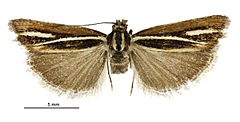Orocrambus thymiastes facts for kids
Quick facts for kids Orocrambus thymiastes |
|
|---|---|
 |
|
| Female | |
| Scientific classification | |
| Kingdom: | |
| Phylum: | |
| Class: | |
| Order: | |
| Family: | |
| Genus: | |
| Species: |
O. thymiastes
|
| Binomial name | |
| Orocrambus thymiastes Meyrick, 1901
|
|
The Orocrambus thymiastes is a small moth that belongs to the Crambidae family. It was first described by a scientist named Edward Meyrick in 1901. This special moth is found only in New Zealand, which means it is endemic to that country. You can find it in the Southland area.
About This Moth
This unique moth is a native resident of New Zealand. It was discovered and named over 120 years ago. Being "endemic" means it naturally lives only in this specific part of the world. You won't find it flying around anywhere else!
What Does It Look Like?
The Orocrambus thymiastes is a fairly small moth. Its wingspan (the distance from one wingtip to the other) is usually between 18 and 23 millimeters. That's about the size of a small coin! The image shows a female moth, which helps us see its typical appearance.
Where Does It Live? (Habitat)
This moth prefers to live in wet, marshy places. These areas are often called "boggy areas." It seems to enjoy habitats where the ground is soft and damp. This type of environment is important for the moth's survival.
The Orocrambus thymiastes is also closely linked to a specific plant. It is often found near Chionochloa rubra, which is a type of tussock grass. This grass might be a food source for the moth's larvae (caterpillars) or provide a safe place for the adult moths to rest.
Life Cycle
Like all moths, the Orocrambus thymiastes goes through a fascinating life cycle. It starts as a tiny egg, which hatches into a larva, also known as a caterpillar. The caterpillar eats and grows, then changes into a pupa. Finally, the pupa transforms into the adult moth we see flying around. Each stage is important for the moth's journey.

